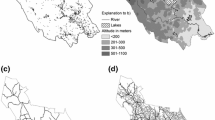Abstract
The hierarchical p-median location-allocation model assumes that patrons always travel to the closest facility of appropriate level and that their interests are best served when the distances they must travel to do this are minimized. This assumption about travel behavior is unrealistic, patrons in the real world are known, for instance, to bypass lower level facilities that can serve their needs to attend higher level facilities. We introduce the concept of “expected distance under referral” to deal with such irrationality and incorporate it into a location-allocation model that minimizes the negative effects of such irrational behavior. We demonstrate the model with several types of non-optimal travel behavior.
Similar content being viewed by others
References
Annis, S. (1981). Physical access and utilization of health services in rural Guatemala. Social Science and Medicine, 15, 515–523.
Batty, M. (1978). Reilly’s challenge: New laws of retail gravitation which define systems of central places. Environment and Planning A, 10, 185–219. doi:10.1068/a100185.
Beaumont, J. R. (1980). Spatial interaction models and the location-allocation problem. Journal of Regional Science, 20, 37–50. doi:10.1111/j.1467-9787.1980.tb00625.x.
Beaumont, J. R. (1987). Location-allocation models and central place theory. In A. Ghosh & G. Rushton (Eds.), Spatial analysis and location-allocation models (pp. 21–54). New York: Van Nostrand-Reinhold.
Christaller, W. (1933). Die Zentralen Orte in Süddeutschland. Jena: Fischer.
Freund, P. J. (1986). Health care in a declining economy: the case of Zambia. Social Science and Medicine, 23, 875–888. doi:10.1016/0277-9536(86)90216-9. Medline.
Fotheringham, A. S. (1983). A new set of spatial interaction models: the theory of competing destinations. Environment and Planning A, 15, 15–36. doi:10.1068/a150015.
Fotheringham, A. S. (1986). Modelling hierarchical destination choice. Environment and Planning A, 18, 401–418. doi:10.1068/a180401.
Fotheringham, A. S., & O’Kelly, M. (1989). Spatial interaction models: formulations and applications. Kluwer Academic: Dordrecht.
Hodgson, M. J. (1978). Toward more realistic allocation in location-allocation models: an interaction approach. Environment and Planning, A, 10, 1273–1285. doi:10.1068/a101273.
Hodgson, M. J. (1981). A Location-allocation model maximizing consumers’ welfare. Regional Studies, 15, 493–506. doi:10.1080/09595238100185441.
Hodgson, M. J. (1984). Alternative approaches to hierarchical location-allocation systems. Geographical Analysis, 16, 275–281.
Hodgson, M. J. (1986). A hierarchical location-allocation model with allocations based on facility size. Annals of Operations Research, 6, 273–289. doi:10.1007/BF02023746.
Hodgson, M. J. (1988). A hierarchical location-allocation model for primary health care delivery in a developing area. Social Science and Medicine, 26, 153–161. doi:10.1016/0277-9536(88)90054-8. Medline.
Hodgson, M. J., & Jacobsen, S. K. (1989). Comparison of a gravity and an expected distance model in a hierarchical inclusive system (Research Report RR 3/89). IMSOR, 26 p.
Kloos, H. (1990). Utilization of selected hospitals, health centres and health stations in central, southern, and western Ethiopia. Social Science and Medicine, 31, 101–114.
Kroll (1988). The multiple-depot, multiple-tour, multiple-stop delivery problem. Ph.D. dissertation, The Johns Hopkins University, Baltimore.
Narula, S. C., & Ogbu, U. I. (1979). An hierarchal location-allocation problem. Omega, 7, 137–143. doi:10.1016/0305-0483(79)90101-4.
O’Kelly, M. E. (1987). Spatial interaction based location-allocation models. In A. Ghosh & G. Rushton (Eds.), Spatial analysis and location-allocation models. New York: Van Nostrand-Reinhold.
O’Kelly, M. E., & Storbeck, J. E. (1984). Hierarchical location models with probabilistic allocation. Regional Studies, 18, 121–129. doi:10.1080/09595238400185121.
Oppong, J. R. (1992). Facility location models for Suhum district, Ghana. PhD. Thesis, Department of Geography, The University of Alberta.
Oppong, J. R. (1996). Accommodating the rainy season in third world location-allocation applications. Socio-Economic Planning Sciences, 30, 121–137. doi:10.1016/0038-0121(96)00006-7.
Oppong, J. R., & Hodgson, M. J. (1994). Spatial accessibility to health care facilities in Suhum district, Ghana. The Professional Geographer, 46, 199–209. doi:10.1111/j.0033-0124.1994.00199.x.
Oppong, J. R., & Hodgson, M. J. (1998). An interaction-based location-allocation model for health facilities to limit the spread of HIV-AIDS in West Africa. Applied Geographic Studies, 2, 29–41. doi:10.1002/(SICI)1520-6319(199821)2:1<29::AID-AGS3>3.0.CO;2-V.
Reilly, W. J. (1929). Methods for the studying of retail relationships (Monograph No. 4). University of Texas, Austin.
Roy, J. R. (2004). Spatial interaction modelling. Berlin: Springer.
Stewart, J. Q. (1941). An inverse distance variation for certain social influences. Science, 93, 89–90. doi:10.1126/science.93.2404.89. Medline.
Stewart, J. Q. (1942). A measure of the influence of a population at a distance. Sociometry, 5, 63–71. doi:10.2307/2784954.
Stock, R. (1983). Distance and the utilization of health facilities in rural Nigeria. Social Science and Medicine, 17, 563–570. doi:10.1016/0277-9536(83)90298-8. Medline.
Tietz, M. B., & Bart, P. (1968). Heuristic methods for estimating the generalized vertex median of a weighted graph. Operations Research, 16, 955–961.
Wilson, A. G. (1971). A family of spatial interaction models, and associated developments. Environment and Planning, 3, 31–32. doi:10.1068/a030001.
Yasenovskiy, V. & Hodgson, J. (2007). Hierarchical location-allocation with spatial choice interaction modelling. Annals of the Association of American Geographers, 97, 496–511.
Author information
Authors and Affiliations
Corresponding author
Rights and permissions
About this article
Cite this article
Hodgson, M.J., Jacobsen, S.K. A hierarchical location-allocation model with travel based on expected referral distances. Ann Oper Res 167, 271–286 (2009). https://doi.org/10.1007/s10479-008-0380-8
Published:
Issue Date:
DOI: https://doi.org/10.1007/s10479-008-0380-8




